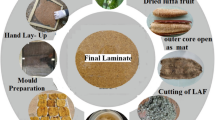Abstract
In this study, the effect of Al2O3 nanoparticles on the heat-transfer properties of medium density fiberboard (MDF) was investigated. Al2O3 nanoparticles were added at two levels (0.5 and 1.0 %) by percentage weight fraction of dry wood fibers to urea formaldehyde (UF) resin. The core temperature profile and thermal conductivity tests showed higher rate of heat transfer after addition of nanoparticles, subsequently it has improved the bonding strength of MDF. Differential scanning calorimetry was used to estimate the heat evolved during the exothermic reaction of UF resin curing. Scanning electron microscopy shows good dispersion of nanoparticles. Thermal conductivity of UF resin improved after nanoparticles addition proved by KD2 pro results. Modulus of rupture, modulus of elasticity and thickness swelling also improved.
Zusammenfassung
In dieser Studie wird der Einfluss von Al2O3 Nanopartikeln auf die Wärmedurchgangseigenschaften von mitteldichten Faserplatten (MDF) untersucht. Al2O3 Nanopartikel wurden in zwei unterschiedlichen Mengen (0,5 % und 1,0 %) bezogen auf das Spantrockengewicht zum Harnstoffharz zugegeben. Prüfungen der Kerntemperatur und der Wärmeleitfähigkeit ergaben eine höhere Wärmedurchgangsrate nach Zugabe von Nanopartikeln und eine Verbesserung der Klebfestigkeit von MDF. Mittels Differenzialrasterkalorimetrie wurde die während der exothermischen Reaktion bei der Härtung von Harnstoffharz abgegebene Wärme geschätzt. Rasterelektronenmikroskopie zeigte eine gute Verteilung der Nanopartikel. Messungen mit dem KD2 pro Gerät belegen, dass sich die Wärmeleitfähigkeit von Harnstoffharz nach Zugabe der Nanopartikel verbessert hat. Die Biegefestigkeit (MOR), der Elastizitätsmodul (MOE) und die Dickenquellung (TS) verbesserten sich ebenfalls.









Similar content being viewed by others
References
Ashori A, Nourbakhsh A (2009) Effect of nanoclay as reinforcement filler on the physical and mechanical properties of wood-based composite. J Comp Mater 43(8):1869–1875
Bolton AJ, Humphrey PE, Kavvouras PK (1989) The hot pressing of dry-formed wood-based composites. Part III. Predicted vapor pressure and temperature variation with time, compared with experimental data for laboratory boards. Holzforsch 43(4):265–274
Dudkin BN, Krivoshapkin VP, Krivoshapkina EF (2006) Effect of aluminium oxide nanoparticles on the properties of urea-formaldehyde resin. Russ J Appl Chem 79(9):1522–1525
Gupta A (2007) Modelling and optimisation of MDF hot pressing. PhD Thesis. University of Canterbury, New Zealand
Irle M, Barbu MC (2010) Wood-based panel technology. In: Heiko T (ed) Wood based panels: an introduction for specialists. Brunel university press, London, pp 1–90
Maloney T (1989) Modern particleboard and dry-process fiber-board manufacturing. Miller Freeman Publications, San Francisco
Pereira CMC, Blanchard C, Carvalho LMH, Costa CAV (2004) High frequency heating of medium density fiberboard (MDF): theory and experiment. Chem Eng Sci 59(4):735–745
Pound J (1973) Radio frequency heating in the timber industry. William Clowes, England
Siimer K, Kaljuvee T, Christjanson P (2003) Thermal behavior of urea formaldehyde resins curing curing. J Therm Anal Calorim 72:607–617
Taghiyari HR (2011) Study on the effect of nano-silver impregnation on mechanical properties of heat-treated Poplus nigra. Wood Sci Technol 45:399–404
Taghiyari HR, Rangavar H, Farajpour Bibalan O (2011) Effect of nano-silver on the reduction of hot pressing time and improvement in physical and mechanical properties of particleboard. Bioresource 6(4):4067–4075
Acknowledgments
The financial support (RDU: 100313) of University Malaysia Pahang is gratefully acknowledged. The authors acknowledge the support by M/s Robin Resources (M) Sdn. Bhd. for supplying rubber wood fibers and M/s Dynea Malaysia Sdn. Bhd. (171040-P) for supplying urea formaldehyde resin used for conducting the experiments.
Author information
Authors and Affiliations
Corresponding author
Rights and permissions
About this article
Cite this article
Kumar, A., Gupta, A., Sharma, K.V. et al. Use of aluminum oxide nanoparticles in wood composites to enhance the heat transfer during hot-pressing. Eur. J. Wood Prod. 71, 193–198 (2013). https://doi.org/10.1007/s00107-013-0664-9
Received:
Published:
Issue Date:
DOI: https://doi.org/10.1007/s00107-013-0664-9




